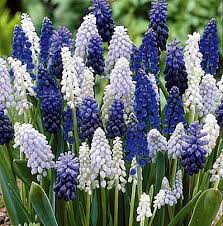Grape hyacinths (Muscari spp.) are perfect for brightening your garden in early spring. These charming flowers are admired for their vibrant colors and sweet, light fragrance. Available in various hues like royal blue, violet, pale blue, pink, white, yellow, and even bicolor, grape hyacinths are visually stunning, especially when mass planted. They thrive in beds, borders, containers, rockeries, and even naturalized settings like lawns and woodlands. Moreover, they multiply quickly, ensuring a beautiful show year after year with minimal maintenance. Tall varieties are also perfect as cut flowers or for forcing indoors to enjoy during winter.
Here are 9 grape hyacinth species that will bring your spring garden to life:
1. M. armeniacum (Armenian Muscari)
This popular variety is known for its vigorous growth and stunning cobalt blue to royal purple flowers. Hardy in Zones 4-8, the blooms grow in tightly packed racemes on 6- to 8-inch stems. It’s ideal for mass planting under deciduous trees, in borders, or containers. Armenian muscari are lightly fragrant and come in blue, pink, and white cultivars, making them versatile and eye-catching.
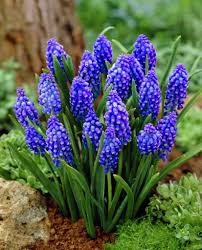
- Cultivar to try: ‘Delft Blue Mix’ (blue, white, and purple mix) or ‘Blue Grape’ (solid blue).
2. M. aucheri
M. aucheri offers delicate, bicolored blooms in shades of china or periwinkle blue with white tips. This compact species, with 4- to 6-inch stems, blooms early in spring and emits a light fruity fragrance. It thrives in Zones 5-9 and is perfect for borders, containers, or planting with daffodils and tulips.
- Cultivar to try: ‘Dark Eyes’, known for its sapphire blue flowers.
3. M. azureum
Known for its unique fluffy florets, M. azureum features baby blue to white flowers with a loose, bell-like shape. It’s a compact variety with 2- to 5-inch stems and is suitable for the front of beds, containers, or woodlands. Hardy in Zones 4-8, this species has a light grapey scent and creates a soft and delicate look.
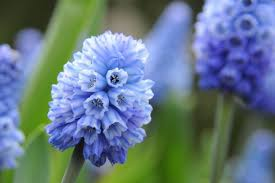
- Also called Pseudomuscari azureum.
4. M. botryoides (Italian Muscari)
This hardy variety grows well in Zones 3-9 and blooms early to mid-spring. Its flowers come in shades from white to indigo blue and have a sweet, honey-musk fragrance. M. botryoides is perfect for the front of perennial beds, containers, or naturalized settings in lawns and woodlands.
- The plants have 5- to 6-inch stems.
5. M. comosum (Tassel Grape Hyacinth)
A standout for its unique, candelabra-like flower heads, M. comosum features bright neon purple florets with striking magenta tips. This tall variety, with 8- to 12-inch stems, blooms in late spring and emits a musky fragrance. Hardy in Zones 4-8, it’s great for beds, borders, or pathways.
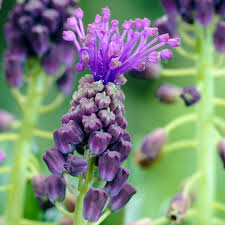
- The unusual flower structure makes it visually striking.
6. M. latifolium
M. latifolium is known for its bicolored flowers—inky blue at the base and lighter blue or white at the tips. With stems reaching up to 12 inches, this species blooms in early spring and has broad leaves similar to tulips. Hardy in Zones 3-8, it’s a fantastic choice for underplanting daffodils and tulips or adding early color to perennial beds.
- Available in packets of 25, 50, or 100 bulbs.
7. M. macrocarpum
A striking bicolor variety, M. macrocarpum features dusty purple blooms that turn yellow as they open. The flowers emit a pleasant fruity fragrance and grow on 6-inch stems. Hardy in Zones 5-8, this variety works well in beds, containers, or as an indoor forcing bulb.
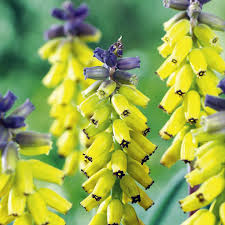
- A great choice for those who love unusual color transitions.
8. M. plumosum (Feather Muscari)
This quirky variety, also known as the “lunatic flower,” features feathery plumes in bright pink to amethyst hues. Blooming on 8- to 12-inch stems in mid- to late spring, M. plumosum has a subtle, sweetly musky fragrance. Hardy in Zones 4-8, it’s perfect for borders, containers, or along pathways.
- Known for its dramatic, feathery appearance.
9. M. paradoxum (Bellevalia)
M. paradoxum offers a stunning display of jewel-like colors, with florets that start as teal green and transform into purple. The blooms feature contrasting yellow margins and tiny yellow stamens. Hardy in Zones 4-8, this species is great for planting in waves or groupings, creating a striking effect. Its fragrant flowers bloom atop 12-inch stems in mid-spring.
- Ideal for planting alongside white tulips or small narcissi for dramatic contrast.
Conclusion
Grape hyacinths are an excellent choice for gardeners looking for low-maintenance, colorful, and fragrant spring blooms. Whether you’re new to gardening or a seasoned pro, these species will add beauty and charm to your garden. Consider experimenting with one or more varieties to enjoy their vibrant colors and delightful fragrance throughout the season.
